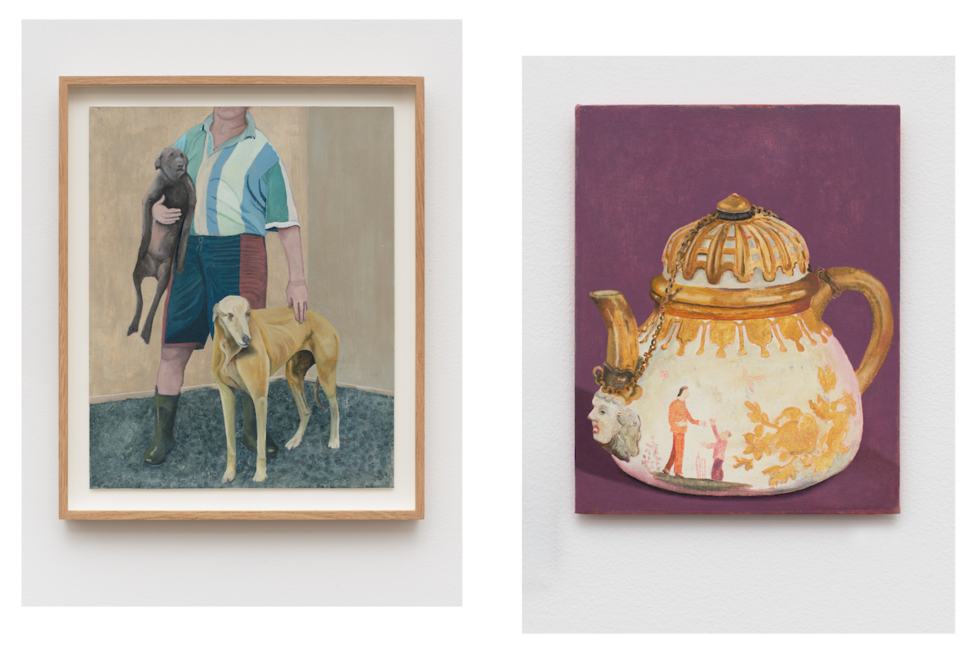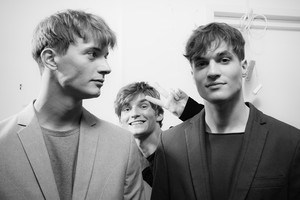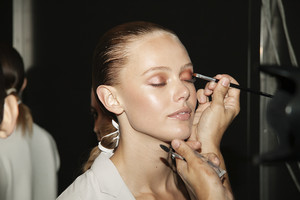I told you I'd be home most of the day - a meditation on longing by Josef Jägnefält
Written by Natalia MunteanSwedish artist Josef Jägnefält’s first solo exhibition at Saskia Neuman Gallery, I told you I'd be home most of the day, invites viewers into a world where ordinary objects become powerful carriers of hidden stories and emotions.
Throughout the exhibition, we are invited to explore the delicate balance between stillness and longing, where the most intimate objects become reflections of human desire. “I don’t think about a story,” says Jägnefält, “I think about the colour and how to get there.” This focus on details and colour lends the works a quiet yet powerful emotional resonance and captures the tension between what is revealed and what is left unsaid, offering a visual meditation on longing and desire.
I told you I'd be home most of the day will be on display until September 26th at Saskia Neuman Gallery in Stockholm.
Natalia Muntean: Could you tell me a bit about how you started as an artist? Was there a decisive moment when you realised this was what you wanted to do?
Josef Jägnefält: I applied to art school, encouraged by friends and family. I initially studied printmaking, but when I applied to university, I focused on painting full-time.
NM: Did you grow up in a family of artists?
JJ: My mother was a teacher who sometimes taught art classes, though she wasn’t a trained art teacher. She enjoyed it, and her mother was also an amateur painter. It was always present in the family, but no one pursued it as a career until me. My brother is an architect, which is somewhat close.
NM: Do you have any routines or methods that help get you into a creative mindset?
JJ: Going to the studio every day and just continuing to work is key. Eventually, something happens. My process is slow, using small brushes. It sometimes feels like I haven't done anything for a week, but when I return to the work, I realise things have moved forward.
NM: How does the journey go from gathering images to creating a painting? And how do you decide which ones will become paintings?
JJ: I save images on my phone or computer, and they can come from anywhere—books, online, or even everyday observations. Everything gets processed digitally, but I like to print the image to have a physical copy. From there, I might make a simple drawing or use transfer paper to trace it onto canvas or another surface.
It’s a very intuitive process. I might find an image, save it, and maybe a year later it resurfaces when it feels ready. It’s not immediate; it’s more about timing and seeing when an image feels right. I print a lot of images and experiment. Instead of starting with a big painting, I might begin with a smaller one to test it. Over time, I’ve painted over so many works, only to later find a picture of the original painting and realise it was interesting. But by then, it’s gone because I painted over it. I’ve ruined many paintings like that and regretted it later. Now, I try to stop before I get to that point, so I can restart the same painting if I need to.
NM: How do you decide which materials to use for a painting? What materials or techniques are important for expressing the feelings you want to convey?
JJ: I used to buy large canvases and aim for perfection, but it became time-consuming and creatively limiting. After moving to Stockholm, I began using scrap materials like MDF or wood from building sites, which brought more variety into my work. The paint itself is very important. I usually use acrylic paint, which can be in any colour, for my larger paintings. With acrylics, I can be adventurous and use different colours, mixing them as I like. With oils, I limit myself to five colours, inspired by LS Lowry, a British painter known for his industrial landscapes of people in Manchester. This approach has significantly impacted my paintings, as it has forced me to really focus on finding the right colour. I enjoy the challenge of reproducing a printed pattern as closely as possible, but sometimes I can’t get the exact colour I want, which leads to something unexpected and I enjoy that.
NM: Are there any materials you’d like to work with in the future?
JJ: I’m always curious about new materials. My girlfriend is also an artist, and though she doesn’t paint, she uses a lot of different materials in her work. That’s a great source of inspiration, and we often share materials.
NM: Do you give each other feedback on your work?
JJ: Always! It’s important to have people you trust. I invite a few close friends to the studio to ask for their opinions. Sometimes you need an outside perspective to see if a piece is finished or if it works.
NM: How do you know when a painting is finished?
JJ: Sometimes I’m afraid of ruining it, so I stop. There are examples where I stopped too early, but that became a part of the piece. When I put the frame on, it’s like saying goodbye to the painting.
NM: When you blend different sources like art history, photography, and magazines, do you feel you're creating a new story, or are you highlighting elements of existing ones?
JJ: It’s a mix. It becomes a narrative, but it's not a clear-cut story. I don't have a storyboard or an ending. I want to surprise myself by putting images next to each other, and something happens. I'm not sure what it is, but it's fun to do.
NM: I imagine that it's like a puzzle? You mix and match the pictures?
JJ: I keep painting, and when the paintings are ready, something happens. I might work on several paintings at a time. Many of them get discarded, put on a shelf, and then, much later, I find something interesting and continue working. It might take a couple of years to finish a painting, but usually, it's a week.
NM: So you go back to the ones you’ve put on the shelf?
JJ: I save them. I have a lot from years ago. The oldest ones are in the basement where I live. I don’t think I’ll start working with them again.
NM: Do you think some of the things you paint are parts of your memories, that you're attracted to certain images?
JJ: Of course. When I see an image and I'm drawn to it, I think it’s my gut feeling signalling. I really believe in that, and I have to stay true to it.
NM: How do you choose which elements you will distort in an image?
JJ: It's just the painting process. Maybe when I get tired or bored with something, I start to change it. It's always about trying to get lost and not finding a way back.
NM: So would you say your work is more intuitive or intentional?
JJ: It's more intuitive.
NM: In “I told you I’d be home most of the day” you have paintings of objects or fragments of objects, like the couch, the dogs or the teapot. How do you see their role in expressing hidden stories or deeper feelings?
JJ: The way I work is more about getting interested in the image. I don't think about a story, I think about the colour and how to get there. Sometimes I aim for photorealism, but other times I get bored, or something happens during the process that takes it elsewhere. That’s part of the process. I didn’t know what the show would look like when I arrived at the gallery to install it. I’ve been trying things out in my studio, but when I got here, with the bigger walls, something else happened. I’m open to this change. I don’t have all the answers; I’m looking for them, just like the audience.
NM: You just ask the questions. Can you tell me a bit about the title of the exhibition?
JJ: I’ve been working with Staffordshire dogs or figurines of Staffordshire dogs for a couple of years and the title, “I told you I would be home most of the day,” came from an Oxford Dictionary example sentence. It connected with the dogs in a way that made sense to me. It follows the same logic as the images—I choose what works, even if I don’t fully understand why.
NM: What caught your interest when it came to the dogs?
JJ: I came across them at a flea market. I had never had a relationship with these figurines, but seeing so many at once was overwhelming. I wanted to buy them all and work with them, but they were too expensive. Even though I didn’t buy them, I kept thinking about them and eventually found them everywhere. There is also a story that made me want the dogs even more. In the 18th or 17th century, sailors bought them in English harbours and took them home. It’s rumoured that people would place the dogs on windowsills or fireplaces, and depending on how they were positioned—head-to-head or facing away—it would send a message. One way meant “no-go,” and the other was a signal that meant the lover could visit. When I was preparing for the show, I realised I hadn’t used this story in my work yet.
NM: So you had the dogs, the love triangle story, and the title. What came first—the paintings, the story, or the dogs?
JJ: It was a slow process. The images are different, but there’s a red thread tying them together. I wanted the story to be the ghost behind the exhibition, allowing viewers to interpret the details.
NM: Your work seems to focus on small, sometimes unnoticed details of life. What attracts or inspires you about these elements?
JJ: I think I enjoy looking at things, at small details in everyday objects, like the armrest of our Italian couch. I’ve been looking at this couch for so long, especially the armrest. It's almost abstract when you view it—it’s just two fields of colour. In the beginning, I saw it like that, just two colours. I kept it that way for a long time, and then I added movement to it. But I wasn’t thinking about couches and romance. My grandfather used to say to me that I got too close when drawing and that I would turn blind from straining my eyes. But I always liked focusing on details—there's a microcosmos everywhere. I sit in the corner of the studio with the painting on the easel. It’s not like a Jackson Pollock explosion—it’s very quiet. I think my images are quiet too. It’s like fishing - nothing happens on the surface, but there’s something beneath, waiting to change.
NM: I agree they are quiet, but I don’t think there’s not much happening. The idea of longing seems central to this exhibition. How do you approach expressing such an intangible feeling in visual art?
JJ: I don’t have an answer for that. It’s very intuitive—how it turns out is just how it turns out.
NM: So, it's quite a meditative and introspective process?
JJ: Yes, but sometimes the opposite—crazy. Especially with deadlines. I build all my canvases and many of the frames, and when I’m frustrated, I hammer away—anger management. One of the portraits in this exhibition sat on the shelf for a while. I couldn’t get her face right. She was longing for something, but I ended up splashing paint over her—she turned purple or blackish red and disappeared behind the surface. I left the studio. A month later, I came back, and she was still looking at me, still longing.
NM: How do you know when it’s ready? When it’s time to stop?
JJ: Sometimes I’m afraid of ruining it, so I stop. There are examples where I stopped too early, but that became part of the piece—just realising I painted only a part of it. I think putting the frame on is my way of saying goodbye. Usually, I paint on just the board or wood, and when I build the frame, it feels like a final step—a way to let go.
NM: How has your work evolved over the years?
JJ: In art school, I wanted to be a painter of big, splashy, gestural works. I was inspired by German painters and American abstract expressionists. My classmates and I inspired each other, but it was a mismatch for me as a person. My graduation paintings were two by four meters—really big. But after art school, I travelled and needed to shrink my work to fit in a suitcase. When I moved to Malmö, I had a small studio in my apartment, so I couldn’t paint large pieces either. Eventually, I found that working on a smaller scale suited me better, allowing me to focus more on details. I think this detail-oriented quality about them was always there, but I took detours and kept coming back to focusing on details.
NM: Is there a specific emotional response you'd like viewers to have when they see the exhibition?
JJ: The response to the exhibition has been overwhelming. I could never have planned for it. There were a lot of people, and many kind things were said. Right now, it’s hard to answer that question, but I hope the audience sees parts of me in the work. I want them to have their own stories, and maybe together, we can create a new one.
NM: So you paint and then let the work have its own life, in a way.
JJ: No, I want them to spend a long time with me first. I need to have spent a lot of time with them.
NM: Is that because you're a perfectionist or why is that?
JJ: It’s more about having a dialogue with the painting if that makes sense.
NM: I'd love to hear more about that dialogue.
JJ: I want the paintings to grow into good paintings, even if they’re not perfect—because no painting is perfect. The source material is just that—source material. The painting has to stand by itself and be ready.
NM: What's next for you?
JJ: I'm longing for the studio. It's been a couple of nerve-wracking weeks before this exhibition, with ups and downs, so I want to get back to the studio. My girlfriend and I plan to visit Norway to look at some art and get new inspiration, and then we'll see. Nothing is planned, which is nice.









